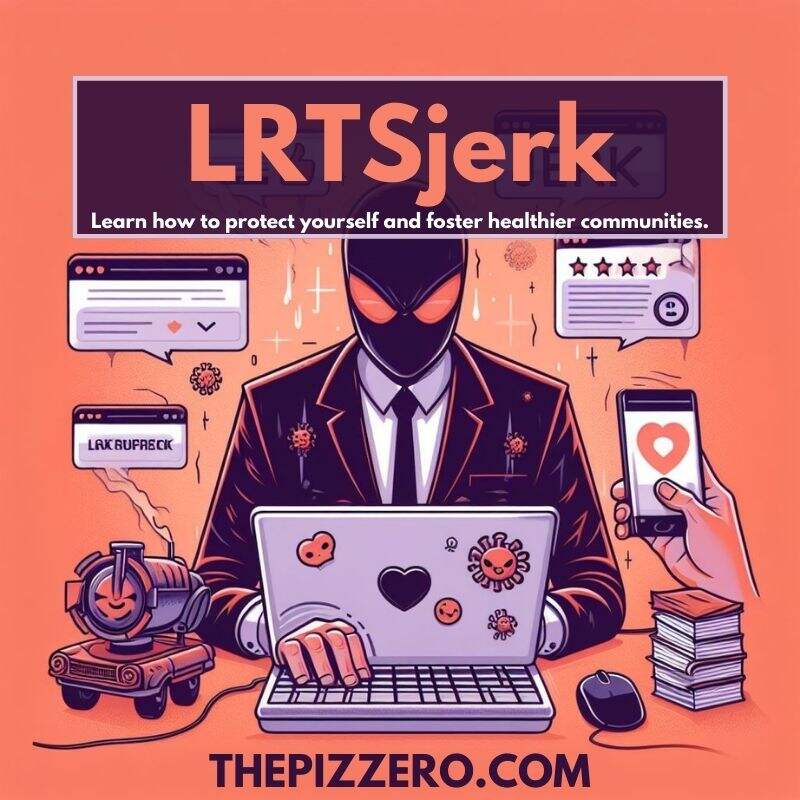LRTSjerk: What is it? Combatting Online Toxicity

lrtsjerk
Have you ever encountered someone online who seemed determined to stir up trouble, insult others, and ruin the atmosphere of a conversation? Chances are, you’ve crossed paths with an LRTSjerk. These toxic individuals thrive on creating chaos and distress. Let’s delve into the world of LRTSjerks and explore how to combat their damaging influence.
Table Of Contents
What is an LRTSjerk?
The term “LRTSjerk” is a relatively new addition to the online lexicon, blending the words “lots” and “jerk.” It describes a specific kind of internet user who consistently engages in toxic and disruptive behaviors. While there’s no single checklist to definitively identify an LRTSjerk, here’s a breakdown of what to look out for:
- Trolling: LRTSjerks deliberately post inflammatory, off-topic, or provocative content with the sole intention of upsetting others and disrupting conversations. They thrive on getting emotional reactions.
- Harassment: This goes beyond mere annoyance and into focused attacks on individuals. LRTSjerks might use insults, threats, or the spreading of personal information to cause distress to their targets.
- Doxxing: LRTSjerks may engage in doxxing, which involves researching and publicly sharing someone’s private information (like their address or phone number) often with malicious intent.
- Cyberbullying: LRTSjerks often participate in cyberbullying, using the anonymity and reach of the internet to relentlessly target and humiliate others. This can be especially damaging towards younger or more vulnerable individuals.
- Persistent Negativity: A hallmark of an LRTSjerk is an unending stream of negativity. Regardless of the topic, they’ll find ways to be confrontational, insult others, and derail positive discussions.
It’s important to note that not everyone who occasionally acts rudely online is an LRTSjerk. The defining feature is the pattern of consistent, malicious behavior designed to create chaos and harm within online communities.
The Psychology of an LRTSjerk
Understanding the motivations behind LRTSjerks isn’t about excusing their behavior, but it can help us address the root of the problem. While each individual is different, some common factors contribute to this toxic online persona:
- Anonymity: The internet often provides a sense of anonymity, emboldening people to say and do things they wouldn’t in a face-to-face setting. This perceived lack of consequences can fuel an LRTSjerk’s sense of power and invulnerability.
- Boredom: For some, trolling and stirring up drama becomes a warped form of entertainment to alleviate boredom. The reactions they get can be addictive, even if those reactions are negative.
- Desire for Attention: LRTSjerks may crave attention, both positive and negative. By being disruptive, they put themselves at the center of online conflict, even if it earns them infamy.
- Underlying Personal Issues: In some cases, LRTSjerk behavior masks deeper insecurities, frustrations, or even mental health struggles. The internet becomes an outlet to lash outat others and gain a sense of control that may be lacking in their offline lives.
The Role of Online Disinhibition
The Online Disinhibition Effect is a crucial concept in understanding LRTSjerks. In online environments, factors like physical distance, anonymity, and the lack of immediate social cues reduce inhibitions that normally guide behavior. This can lead to a disconnect between online and offline selves, allowing some individuals to act in callous and destructive ways that they might not consider in real-world interactions.
Important Note: It’s essential not to fall into the trap of armchair psychology. While understanding these motivations is helpful, it doesn’t excuse an LRTSjerk’s harmful actions. They are still responsible for the damage they cause.
The Negative Impacts of LRTSjerks
LRTSjerks create a toxic atmosphere that ripples far beyond their immediate targets. Here’s a breakdown of the harm they can cause:
- Damage to Mental Health of Victims: Repeated exposure to harassment, insults, and threats can inflict significant emotional wounds. Victims of LRTSjerks may experience anxiety, depression, lowered self-esteem, and even symptoms of PTSD in severe cases.
- Disruption of Online Communities: LRTSjerks poison online spaces by derailing conversations, forcing people to disengage, and creating an atmosphere of hostility that drives away genuine participants.
- Erosion of Trust in Online Spaces: The presence of LRTSjerks diminishes the feeling of safety and trust within online communities. The fear of attracting unwanted attention can lead people to self-censor and withdraw from meaningful participation online.
How to Identify an LRTSjerk
Recognizing patterns of behavior is crucial for protecting yourself from LRTSjerks:
- Persistent Negativity: They seem incapable of positive contributions, always finding ways to criticize, insult, or derail the conversation.
- Inflammatory Language: LRTSjerks use deliberately provocative language designed to trigger emotional responses.
- Targeting Individuals: Rather than engaging with ideas, LRTSjerks often focus on personal attacks, insults, and attempts to discredit specific individuals.
Dealing with LRTSjerks
- Don’t Feed the Troll: Arguing with an LRTSjerk rarely works. They want attention, and your engagement fuels them. Disengaging is often the most effective strategy.
- Reporting and Blocking Tools: Most social media platforms offer ways to report abusive behavior and block problematic users. Use these tools liberally.
- Seeking Support: If you’re the target of an LRTSjerk, don’t suffer in silence. Reach out to friends, family, or online support resources for help.
Strategies for Protecting Yourself
- Maintaining Strong Privacy Settings: Take control of who can see your information on social media platforms.
- Being Cautious About Sharing Personal Information: Avoid oversharing details that could be used against you, like your address or workplace.
- Developing Online Resilience: Learn to identify and detach from toxic behavior. Focus on building positive connections and engaging in healthy online spaces.
Building Healthier Online Communities
- The Role of Moderation: Effective moderation is essential for creating welcoming communities. This includes clear rules and swift action against disruptive behavior.
- Fostering Positive Online Norms: Proactively encourage respect, empathy, and constructive dialogue to counter the influence of LRTSjerks.
- Emphasizing Empathy and Respect: Remind people there’s a human being on the other side of the screen. Promoting awareness and accountability can contribute to a less toxic online environment.
Beyond the Individual: Systemic Issues
- Examining How Platform Design Can Inadvertently Encourage Toxic Behavior: Some platform features (like anonymity options or reward systems based on engagement) can unintentionally amplify LRTSjerk behavior.
- The Need for Greater Accountability from Social Media Companies: We need more pressure on platforms to take responsibility for the toxic environments they often allow to fester.
Real-Life Stories and Resources
Understanding the true impact of LRTSjerks goes beyond definitions. To illustrate their destructive behavior, consider these anonymized examples (note: if you can obtain permission to share real stories, that’s even more powerful):
- Example 1: The Targeted Writer: A blogger who writes about social justice issues received a barrage of insults and threats from a group of LRTSjerks after one of their articles went viral. The harassment made them consider abandoning their online platform altogether.
- Example 2: The Discord Community Raid: A friendly online gaming community was invaded by LRTSjerks who flooded their chat with offensive memes, spam, and hateful language, disrupting their regular activities and causing distress among members.
- Example 3: The Doxxing Nightmare: A young woman had her personal information, including her home address, leaked online by an LRTSjerk after a minor disagreement on a social media platform. This led to fear and anxiety for her safety.
Important Note: These examples are distressingly common. They highlight the importance of having the right resources available for those targeted by LRTSjerks.
Also Read: StandartProductfld: Mac Browser Hijacker Removal & Protection
Resources for Victims of Online Harassment
If you or someone you know is being harassed by LRTSjerks, these resources can help:
- The Cyberbullying Research Center: (https://cyberbullying.org/) Provides a wealth of information, support and guidance for victims, parents, and educators.
- The National Suicide Prevention Lifeline: 1-800-273-8255 (Offers 24/7 confidential support for those in emotional distress)
- Crisis Text Line: Text HOME to 741741 (Connects you with a crisis counselor for support via text message)
- The Online Abuse Prevention Initiative ([invalid URL removed]): Focuses on education and resources to combat online harassment in its various forms.
Additional Tips:
- Document the Harassment: Keep screenshots, records of dates and times, and any other relevant information.
- Reach Out to Platform Support: Most social media platforms have mechanisms for reporting abuse.
- Consider Legal Action: In severe cases, especially those involving doxxing or threats of violence, consulting a lawyer may be necessary.
Remember, you are not alone. Help is available, and taking action can empower you to reclaim your online space.
Conclusion: Combating the LRTSjerk Menace
The rise of the LRTSjerk highlights the dark side of online interaction. Their toxic behavior inflicts genuine pain, silences voices, and undermines the positive potential of the internet. However, it doesn’t have to be this way. By understanding the problem, taking a stand against it, and supporting those targeted, we can work towards healthier and more inclusive online spaces.
Here’s a recap of the key takeaways:
- LRTSjerks thrive on negativity and attention: Disengaging from their provocations and using reporting tools are effective strategies.
- Protecting yourself is essential: Maintain strong privacy settings, think carefully about what you share, and develop online resilience.
- Communities need proactive measures: Clear rules, effective moderation, and fostering a culture of respect create environments less welcoming to LRTSjerks.
- Systemic change is necessary: Social media companies must be held accountable for creating platforms that can fuel toxicity.
Ultimately, the fight against LRTSjerks is about preserving what makes the internet great: connection, creativity, and the free exchange of ideas. By refusing to tolerate their destructive behavior, we can make online spaces safer for everyone.
A Call to Action
Share this article to spread awareness about LRTSjerks. Support victims of online harassment. Advocate for greater accountability from social media platforms. Together, we can build a better online world.







